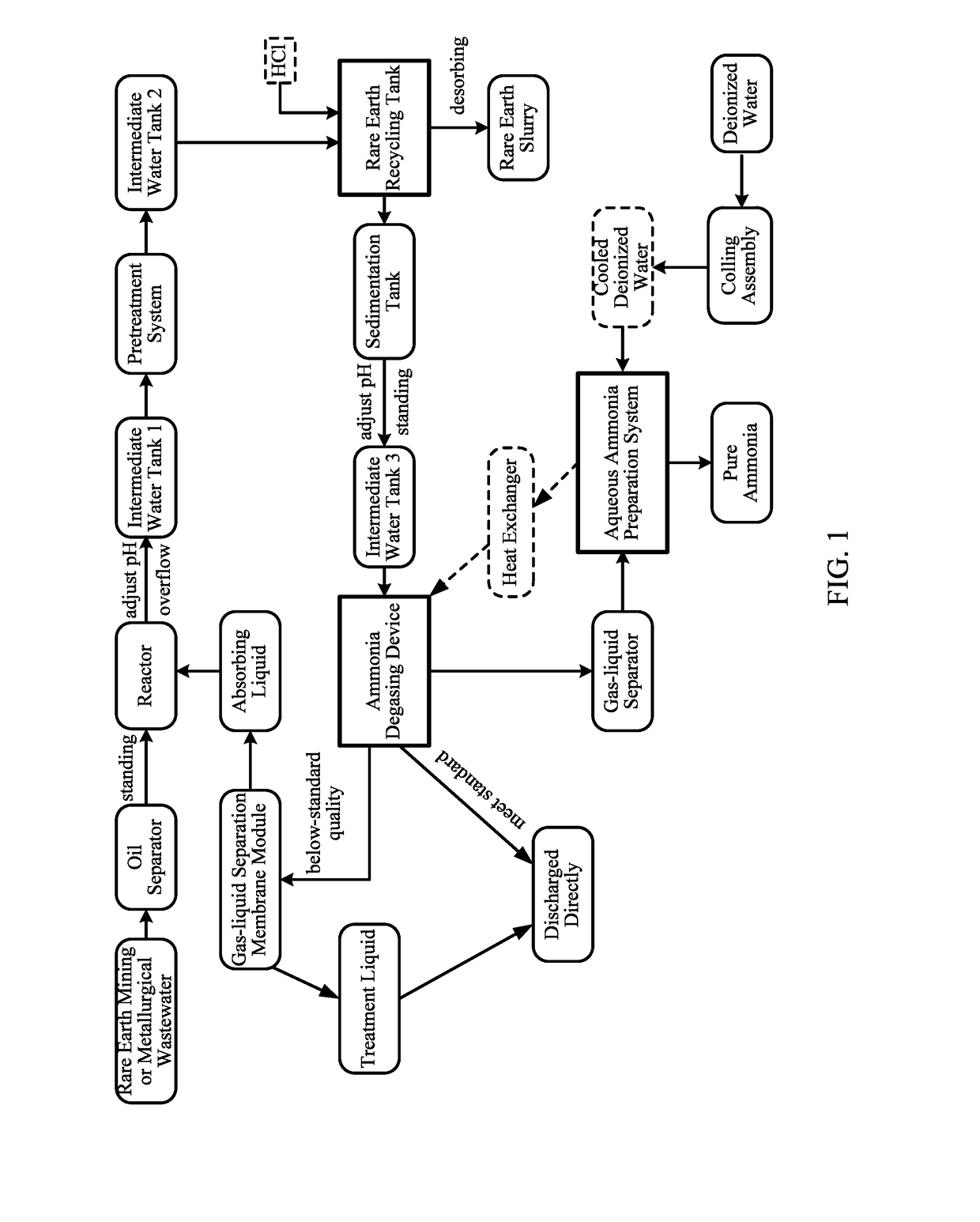System and method for recycling rare earth and ammonia nitrogen from rare earth wastewater
a rare earth and wastewater technology, applied in the field of rare earth and ammonia nitrogen recycling system, can solve the problems of reducing the recovery rate of rare earth wastewater, affecting the surrounding environment, and large quantities of wastewater produced during mining and smelting separation of rare earth, etc., and achieves the effects of low cost, small investment, and simple process
- Summary
- Abstract
- Description
- Claims
- Application Information
AI Technical Summary
Benefits of technology
Problems solved by technology
Method used
Image
Examples
example 1
[0039]A wastewater from rare earth mining was provided. The determined rare earth content of the wastewater was 34.4 mg / L, and the determined ammonia nitrogen concentration of the wastewater was 293.2 mg / L. The wastewater is fed to an oil separator tank at a flow rate of 1000 L / h, stood for a moment, and then removed of the oil. The wastewater after oil removal was guided to a reaction tank, adjusted to pH 3-5 with sodium hydroxide, and fed to an intermediate water tank 1 by overflowing. The wastewater with adjusted pH in the intermediate water tank 1 was introduced by using a lift pump sequentially to a walnut shell filter tank, a manganese sand filter tank, a quartz sand filter tank, and an activated carbon filter tank in a pretreatment system for clarification (or purification). The wastewater after treatment was introduced to an intermediate water tank 2. The wastewater in the intermediate water tank 2 was introduced to a rare earth recycling tank using a lift pump at a flow rat...
example 2
[0040]A wastewater from rare earth smelting separation plant was provided. The determined rare earth content of the wastewater was about 360.33 mg / L, and the determined ammonia nitrogen concentration of the wastewater was about 210.89 mg / L. The wastewater is fed to an oil separator tank at a flow rate of 2000 L / h, stood for a moment, and then removed of the oil. The wastewater after oil removal was guided to a reaction tank, adjusted to pH 3-5 with sodium hydroxide, and fed to an intermediate water tank 1 by overflowing. The wastewater with adjusted pH in the intermediate water tank 1 was introduced by using a lift pump sequentially to a walnut shell filter tank, a manganese sand filter tank, a quartz sand filter tank, and an activated carbon filter tank in a pretreatment system for clarification. The wastewater after treatment was introduced to an intermediate water tank 2. The wastewater in the intermediate water tank 2 was introduced to a rare earth recycling tank using a lift pu...
example 3
[0041]A wastewater from rare earth smelting separation plant was provided. The determined rare earth content of the wastewater was about 456.58 mg / L, and the determined ammonia nitrogen concentration of the wastewater was about 20036.66 mg / L. The wastewater is fed to an oil separator tank at a flow rate of 1500 L / h, stood for a moment, and then removed of the oil. The wastewater after oil removal was guided to a reaction tank, adjusted to pH 3-5 with sodium hydroxide, and fed to an intermediate water tank 1 by overflowing. The wastewater with adjusted pH in the intermediate water tank 1 was introduced using a lift pump sequentially to a walnut shell filter tank, a manganese sand filter tank, a quartz sand filter tank, and an activated carbon filter tank in a pretreatment system for clarification. The wastewater after treatment was introduced to an intermediate water tank 2. The wastewater in the intermediate water tank 2 was introduced to a rare earth recycling tank using a lift pum...
PUM
| Property | Measurement | Unit |
|---|---|---|
| flow rate | aaaaa | aaaaa |
| flow rate | aaaaa | aaaaa |
| flow rate | aaaaa | aaaaa |
Abstract
Description
Claims
Application Information
 Login to View More
Login to View More - R&D
- Intellectual Property
- Life Sciences
- Materials
- Tech Scout
- Unparalleled Data Quality
- Higher Quality Content
- 60% Fewer Hallucinations
Browse by: Latest US Patents, China's latest patents, Technical Efficacy Thesaurus, Application Domain, Technology Topic, Popular Technical Reports.
© 2025 PatSnap. All rights reserved.Legal|Privacy policy|Modern Slavery Act Transparency Statement|Sitemap|About US| Contact US: help@patsnap.com

